Metabolism of indole-3-acetic acid in Arabidopsis
- PMID: 9733548
- PMCID: PMC34867
- DOI: 10.1104/pp.118.1.285
Metabolism of indole-3-acetic acid in Arabidopsis
Abstract
The metabolism of indole-3-acetic acid (IAA) was investigated in 14-d-old Arabidopsis plants grown in liquid culture. After ruling out metabolites formed as an effect of nonsterile conditions, high-level feeding, and spontaneous interconversions, a simple metabolic pattern emerged. Oxindole-3-acetic acid (OxIAA), OxIAA conjugated to a hexose moiety via the carboxyl group, and the conjugates indole-3-acetyl aspartic acid (IAAsp) and indole-3-acetyl glutamate (IAGlu) were identified by mass spectrometry as primary products of IAA fed to the plants. Refeeding experiments demonstrated that none of these conjugates could be hydrolyzed back to IAA to any measurable extent at this developmental stage. IAAsp was further oxidized, especially when high levels of IAA were fed into the system, yielding OxIAAsp and OH-IAAsp. This contrasted with the metabolic fate of IAGlu, since that conjugate was not further metabolized. At IAA concentrations below 0.5 microM, most of the supplied IAA was metabolized via the OxIAA pathway, whereas only a minor portion was conjugated. However, increasing the IAA concentrations to 5 microM drastically altered the metabolic pattern, with marked induction of conjugation to IAAsp and IAGlu. This investigation used concentrations for feeding experiments that were near endogenous levels, showing that the metabolic pathways controlling the IAA pool size in Arabidopsis are limited and, therefore, make good targets for mutant screens provided that precautions are taken to avoid inducing artificial metabolism.
Figures
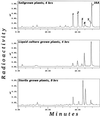

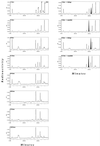
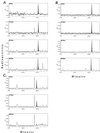
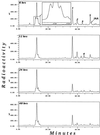
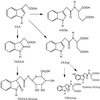
Similar articles
-
Metabolism of indole-3-acetic acid by orange (Citrus sinensis) flavedo tissue during fruit development.Phytochemistry. 2001 May;57(2):179-87. doi: 10.1016/s0031-9422(01)00023-1. Phytochemistry. 2001. PMID: 11382233
-
A Novel Metabolic Pathway for Indole-3-Acetic Acid in Apical Shoots of Populus tremula (L.) x Populus tremuloides (Michx.).Plant Physiol. 1994 Dec;106(4):1511-1520. doi: 10.1104/pp.106.4.1511. Plant Physiol. 1994. PMID: 12232425 Free PMC article.
-
Metabolism of Auxin in Tomato Fruit Tissue: Formation of High Molecular Weight Conjugates of Oxindole-3-Acetic Acid via the Oxidation of Indole-3-Acetylaspartic Acid.Plant Physiol. 1992 Nov;100(3):1396-402. doi: 10.1104/pp.100.3.1396. Plant Physiol. 1992. PMID: 16653136 Free PMC article.
-
Indole-3-acetic acid protein conjugates: novel players in auxin homeostasis.Plant Biol (Stuttg). 2006 May;8(3):340-5. doi: 10.1055/s-2006-923802. Plant Biol (Stuttg). 2006. PMID: 16807826 Review.
-
Current aspects of auxin biosynthesis in plants.Biosci Biotechnol Biochem. 2016;80(1):34-42. doi: 10.1080/09168451.2015.1086259. Epub 2015 Sep 12. Biosci Biotechnol Biochem. 2016. PMID: 26364770 Review.
Cited by
-
Dynamic regulation of auxin oxidase and conjugating enzymes AtDAO1 and GH3 modulates auxin homeostasis.Proc Natl Acad Sci U S A. 2016 Sep 27;113(39):11022-7. doi: 10.1073/pnas.1604458113. Epub 2016 Sep 20. Proc Natl Acad Sci U S A. 2016. PMID: 27651495 Free PMC article.
-
Identification of Auxin Metabolites in Brassicaceae by Ultra-Performance Liquid Chromatography Coupled with High-Resolution Mass Spectrometry.Molecules. 2019 Jul 18;24(14):2615. doi: 10.3390/molecules24142615. Molecules. 2019. PMID: 31323791 Free PMC article.
-
Biosynthesis, conjugation, catabolism and homeostasis of indole-3-acetic acid in Arabidopsis thaliana.Plant Mol Biol. 2002 Jun-Jul;49(3-4):249-72. Plant Mol Biol. 2002. Corrected and republished in: Plant Mol Biol. 2002 Sep;50(2):309-32. doi: 10.1023/a:1016024017872. PMID: 12036253 Corrected and republished. Review. No abstract available.
-
Approaching cellular and molecular resolution of auxin biosynthesis and metabolism.Cold Spring Harb Perspect Biol. 2010 Jan;2(1):a001594. doi: 10.1101/cshperspect.a001594. Cold Spring Harb Perspect Biol. 2010. PMID: 20182605 Free PMC article. Review.
-
Developmental regulation of indole-3-acetic acid turnover in Scots pine seedlings.Plant Physiol. 2001 Jan;125(1):464-75. doi: 10.1104/pp.125.1.464. Plant Physiol. 2001. PMID: 11154354 Free PMC article.
References
-
- Andersson B, Sandberg G. Identification of endogenous N-(3-indoleacetyl)aspartic acid in Scots pine (Pinus sylvestris L.) by combined gas chromatography-mass spectrometry, using high-performance liquid chromatography for quantification. J Chromatogr. 1982;238:151–156.
-
- Bartel B, Fink GR. ILR1, an amidohydrolase that releases active indole-3-acetic acid from conjugates. Science. 1995;268:1745–1748. - PubMed
-
- Bennett JM, Marchant A, Green HG, May ST, Ward SP, Millner PA, Walker AR, Schultz B, Feldmann KA. Arabidopsis AUX 1 gene, a permease-like regulator of root gravitropism. Science. 1996;273:948–950. - PubMed
Publication types
MeSH terms
Substances
LinkOut - more resources
Full Text Sources
Molecular Biology Databases

